
|   |

|   |
Andaaz Kathak dance festival: A confluence of four gharanas - Kiran Java e-mail: kiran@kiranjava.com October 3, 2022 For the first time in Maharashtra, senior Kathak practitioners from all four gharanas (styles) of Kathak classical dance convened on one platform at the Andaaz Kathak classical dance festival. The event was organized by West Zone Cultural Centre (WZCC), Udaipur in collaboration with Dr. Nandkishore Kapote of Nandkishore Cultural Society and was supported by Lalit Kala Kendra, Savitribai Phule Pune University. National and international Kathak exponents of the Lucknow, Raigarh, Banaras, and Jaipur gharanas performed at the festival which ran from 19th to 21st August 2022 at Pt. Jawaharlal Nehru Auditorium and Pt. Bhimsen Joshi Auditorium in Pune. A Kathak gharanas seminar was also held at Lalit Kala Kendra, Savitribai Phule Pune University where the much-awaited book, Sangit Darpan, an offering by the late Kathak legend Pt. Birju Maharaj was launched. 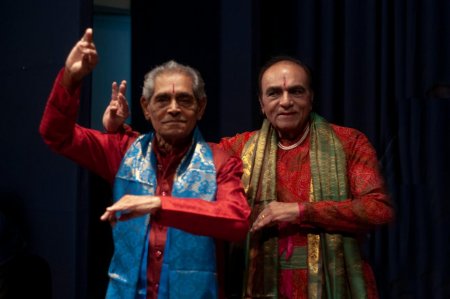 Ramlal Bareth (aged 87) and Dr. Puru Dadheech (aged 83) representing Raigarh and Jaipur gharanas respectively. Photo: Eknath Joshi The tone of the conference was set by the opening speech of Kiran Soni Gupta, Director of West Zone Cultural Centre, Udaipur. Highlighting the importance of art and culture, she said that art is the very soul of society. According to her, when the success of a nation is measured, one always checks the time period when that nation or society reached the zenith of excellence in art and culture. Culture has been an important aspect and has nourished lives from ancient times, whether it is the Egyptian civilization, the Greek civilization, Harappa, or Mohenjodaro. According to her, the main reason why cultural programs are showcased is to educate, entertain and nourish the souls of citizens. Dr. Nandkishore Kapote, who curated this festival, said that presenting the four gharanas of Kathak on one platform aimed to educate students and the audience not only about the beauty of each style of Kathak but also to take pride in our legacy. This is why the most senior artistes in each gharana of Kathak were invited to represent and showcase their presentations at this festival. At the same time, Dr. Kapote felt that it was necessary to nurture young upcoming talent; hence he collaborated with Lalit Kala Kendra Savitribai Phule Pune University to have their promising students perform at this festival. Festival - Day 1 The festival's programme on the first day was brilliantly presented by Renu Sharma, celebrity Kathak guru/mentor, secretary of Alpika Kathak organization, and disciple of Birju Maharaj. Lucknow Style 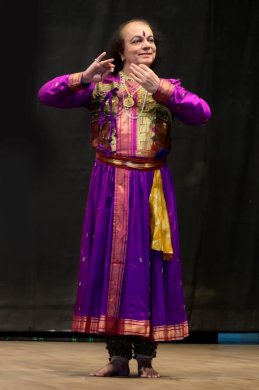 Dr. Nandkishore Kapote depicts Lord Krishna (Photo: Narendra Ghodke) The programme began with a performance by Dr. Nandkishore Kapote representing the Lucknow gharana. Dr. Kapote is a Ph.D. guide at Sri Sri Centre for Kathak Research and other universities, and author of 'Nritya Samrat Pt. Birju Maharaj' amongst others. He opened the event with a mesmerizing performance on the bhajan (devotional song) baaje re muraliya baaje with his iconic Krishna smile and eyes aglow. Dr. Kapote followed this performance with a nritta (pure movement) presentation that he had learned from his guru Birju Maharaj in the last two years of the Covid lockdown period. One can see the usage of the signature hastas (hand movements) of the Lucknow gharana in his dance. One very alluring composition was the tak deemi takita tihai (a rhythmic piece repeating identically three times with equal intervals in between the repetitions) which he performed with graceful movements and an unhurried approach. One could see the aesthetic covering of stage space by Dr. Kapote not only in the bhajan but also in the tukra dhetta ta dhetta kida dhetta by employing movement across and sideways with either circles or diagonal lines. The audience got a special treat of a unique jugalbandhi (friendly competition between two musicians). Titled 'Haar-Jeet', it was performed in a competitive spirit wherein Dr. Kapote's scintillating footwork was sparred against the wizardry of Kalinath Mishra on the tabla. He mentioned that this had been first performed at the Russia festival in 1987. Kalinath Mishra did a fabulous job of keeping up with Dr. Kapote; at one juncture when Dr. Kapote slid his foot on the ground making a very soft sound of his ghunghroo, Kalinath Mishra rose to the challenge by using his tabla tuning hammer to mimic the sound - all within the rhythm. This made everyone in the audience smile. Accompanying his performance were Kalinath Mishra on tabla, Sanjay Garud on vocal, Umesh Purohit on harmonium, Pavan Zodge on pakhawaj, Yash Trisharan on tabla, Azharuddin Shaikh on flute, Vishwajeet Londhe on manjira. Aryav Anand accompanied him for the padhant (recitation of the rhythmic composition). Jaipur Style 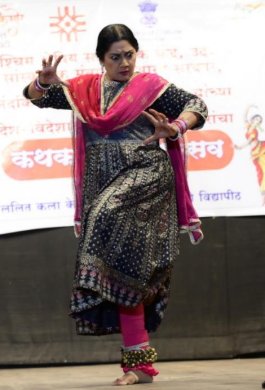 Nandita Puri performs Kaliya Mardan kavitt (Photo: Narendra Ghodke) The next artiste to perform was Nandita Puri, a disciple of Dr. Roshan Kumari of the Jaipur gharana. Nandita Puri is also a famed television actress and has had the opportunity to work with director Shyam Benegal. Nandita Puri has won many awards for her performances in India and abroad. She received the Government of India Scholarship in 1982. Her performance began with a vandana (ode) to the goddess titled Jai Bhagavat Devi. She showcased a few classical compositions of the Jaipur gharana before concluding with a unique kavitt (rhythmic poetry) describing Krishna's lila-play of Kaliya Mardan, an episode from the Bhagavata Purana. Puri did awe-inspiring abhinaya on the kavitt. Next, she performed some exquisite footwork compositions by Roshan Kumari's father, Ustad Fakir Mohammed Pirubaksh, and a traditional Nau ka chand of Dr. Roshan Kumari. She followed it with an artistically rendered chakkardar paran marked by crisp footwork and clean gait. All the padhant and kavitt were splendidly recited by Kalinath Mishra. She obliged Kalinath Mishra's request, by dancing his composition - a bedam tihai (a thrice repeating rhythmic pattern proceeding breathlessly) titled Toofan - the storm. She then performed a 'zordar' paran of Dr. Roshan Kumari, in the veer ras (heroic sentiment) style of the Jaipur gharana. The bol (textual syllables) had complications akin to the weaving of a spider's web and was appropriately named Makari ki jaal. Nandita Puri performed the forceful composition and danced the vigorous movements with considerable virtuosity. Accompanying her performance was Kalinath Mishra on tabla, Vaibhav Mankad on vocal/harmonium, and Azharuddin Shaikh on flute. Banaras Style 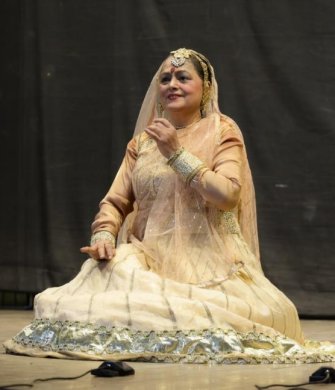 Jayanti Mala Mishra presenting a Banarasi kajari (Photo: Narendra Ghodke) The last performance for the day was by Jayanti Mala Mishra, a 10th generation artiste of the Banaras gharana, daughter of Kathak Queen Sitara Devi, and niece of Acharya Choube Maharaj. She opened with a beautiful stuti Shankar Mahadev dev sevak sab jaane, a tribute to Lord Shiva written by Sukhdev Maharaj. She regaled the audience with the Dhamaar ka Andaaz composition of the Banaras gharana, a chakkardar tukda, and a composition with natawari bol (rhythmic textual syllables of ta thei tat and its derivatives) in the Banaras style - all of which were breathtakingly wonderful. She then performed an old composition Dha taka thunga in the style often rendered by her aunt Tara - seated on the floor - first with dancing eyebrows and then with her expressive eyes. She also performed an old composition, a favourite of her mother Sitara Devi, which was composed by Acharya Choube Maharaj and the famous Bijli gat nikas of Sitara Devi in taal teentaal where she took a few steps forward in the manner of electrifying lightning. Jayanti Mala then executed a kasak masak gat with no sound produced by her ghunghroo (although she was wearing 600 bells), a naulakha paran, kavitt paran (of Sukhdev Maharaj), anaghat toda tukra ending with upaj jugalbandhi. What a treat to watch these dazzling compositions in the Banaras style. She closed with a Banarasi kajari written by Sukhdev Maharaj, lovingly presented and seated on the floor. It was soulfully sung by Somnath Mishra with lilting notes of the flute by Azharuddin Shaikh. Festival - Day 2 The second day of the Andaaz Kathak dance festival was held at Pt. Bhimsen Joshi Auditorium in Aundh. Dr. Sunil Sunkara, Kathak performer and research scholar, was magnificent as sutradhar. He conducted the programme masterfully, captivating the audience with many divine anecdotes as he presented each performance. The show opened with the performance of students of Lalit Kala Kendra Savitribai Phule Pune University, Shruti Patki, and Ameera Patankar. Shruti Patki presented the vandana Kasturi tilakam, an ode to Lord Krishna. She gracefully presented a paran (forceful composition with bols of the pakhawaj) with multiple spins that she had learned from her guru Rajendra Gangani. She also presented a soulful performance on the Draupadi vastra haran gat bhav (rendering of an episode or story with the wholeness of expression in mime) which she learned from her guru Maneesha Sathe. Ameera Patankar began with a magnificent Ganesh vandana performance, followed by an amad which she performed visibly approaching the sam, with technical precision. She was accompanied by her guru Shama Bhate who did the padhant. Also accompanying on padhant was Bhargavi Sardesai. Ameera then presented a traditional composition of Dha Taka Thunga which had a play of thah and dugun, a vision created by Shama Bhate. She closed with the thumri Aise mori rangi hai Shyam, Shyam ghar aye written by Gajendra Ahire, and composed by Gandhar Sangoram who was present in the audience. Musicians accompanying her were Charudatta Phadke on tabla, vocalist Shubham Khandalkar, and Yashwant Thite on harmonium. Lucknow Style Aryav Anand, a Delhi based young upcoming exponent of the Lucknow gharana performed next. A third generation artist, Aryav began his training under his grandfather Balram Lal, and continued under his father Dr. Madhukar Anand. He began his performance with an ode to Lord Ganesh written and choreographed by Birju Maharaj. He then performed various pieces composed by Birju Maharaj during the Covid lockdown including a composition in taal pancham sawari, Deepak Maharaj's tandav, and lasya roop paran (an inter-play of forceful and gentle movements on a rhythmic composition ending on the outer edge of the sam), a tishra chand tihai, and a tukra kran nakita tak composed by his late father Dr. Madhukar Anand. He meticulously explained the back story of each item before presenting it, thus keeping the audience engaged in his performance. Accompanying him were Pune based musicians - vocalist Shubham Khandalkar, Yash Trisharan on tabla, Pavan Zodge on pakhawaj, and Umesh Purohit on harmonium. Raigarh Style 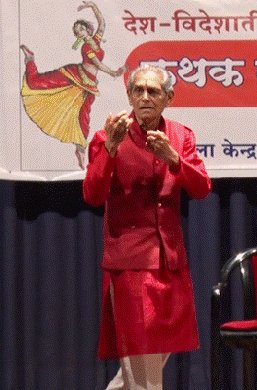 Ramlal Bareth performs on Ghir ghir ayi badariya (Still captured by Kiran Java) The next performance was a presentation of the Raigarh gharana, Kathak classical dance from Raja Chakradhar Singh's famous Raigarh darbar. The programme began with a performance by 87-year-old Ramlal Bareth, who began learning Kathak at the Raigarh darbar. When he performed for the first time at the age of ten, the raja was captivated and took him under his tutelage. Ramlal Bareth mentioned that music and dance experts from Lucknow, Jaipur, and Banaras used to visit the court of Raigarh and it was a proverbial 'Kala ka triveni sangam', a delightful period of Indian culture and heritage. Raja Chakradhar Singh himself created many compositions and developed the dance form. Ramlal Bareth shared that it was customary for Raja Chakradhar to coin unique names for the various compositions, such as Dal Badal, Ghoomar Badal, Chamak Bijli, etc. Ramlal Bareth mesmerized the audience by reciting the Kadak Bijli composition and the Gaj Vilas chakkardar paran emoting the gait of dalliance in nature. He demonstrated abhinaya on the thumri Mohe chedo nahin Shyam and explained the various facial expressions. Then being the dancer that he is, he couldn't help himself and rose from his seat to dance on kajari ghir ghir ayi badariya. He sang while he performed and showed various upma bhav (realistic and allegoric allusions) such as comparing black clouds with the black hair of the nayika. A splendid performance that moved the audience.  Bhupendra Bareth performs a technical presentation in the Raigarh Kathak style Photo: Eknath Joshi Bhupendra Bareth, a senior exponent of Raigarh gharana and son of Ramlal Bareth, opened the next performance with the stuti Mahadeva Shiv har har tribute to Lord Shiva in raag Shankara and taal chautaal. His disciples Nitya Khatri and Priyanka Chouhan accompanied him. He then performed a unique uthaan whose section began from each vibhaag of the taal. This was followed by the upodghaat, a Raigarh term for the Kathak amad performed with old world charm. In the Raigarh tradition, the repertoire consists of compositions in three categories i.e. prakratik (of nature), dhwaniatmak (of sound), kavyaatmak (of poetry), and chitraatmak (of pictures). Bhupendra Bareth performed the Dal Badal in the dhwaniatmak section, Krishna Lasya poetry in the kavyaatmak section, and the Matasya Pakshi Rangavali in the chitraatmak section. Based on mnemonic syllables of the pakhawaj, this composition portrayed how fish are idly swimming in a pond, and how a bird swoops down to hunt the fish and then flies away with its prize, creating a magnificent visual. Ramlal Bareth accompanied him on the padhant. Bhupendra Bareth then closed with a charming performance on a bhav geet considered the piece de resistance, chandra badan mrig lochani composed by Raja Chakradhar Singh. Accompanying artistes were Pradeep Bareth on tabla, Shubham Khandalkar on vocals, Umesh Purohit on harmonium, and Azharuddin Shaikh on flute. Jaipur Style 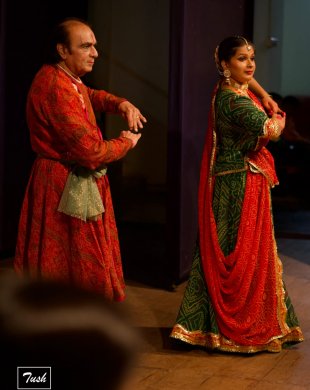 Dr. Puru Dadheech and Harshita Sharma Dadheech perform a technical presentation in ganesh taal Photo: Tush Dadheech The next performance was by the Jaipur gharana represented by Dr. Puru Dadheech and Harshita Sharma Dadheech who began with a Ganesh vandana Jai jayati gaj vadana. They performed a traditional presentation on the ancient taal ganesh. Dr. Dadheech explained that this was a rare taal (time measure) of 21 matras (beats). He first explained its theka and then presented the tatkaar (footwork) of the taal before embarking on the presentation which included the distinctive intra-forms of Kathak thaat, amad, paran et al. The padhant was done by Damayanti Bhatiya Miradwal. The audience was inspired by 83-year-old Dr. Puru Dadheech performing the technical Kathak presentation. Harshita Sharma Dadheech did a solo performance on various compositions; amongst them was the fascinating simha avlokan bandish composed by Dr. Puru Dadheech, an energetic composition by Maharaj Kudau Singh, and a captivating composition by Jailal Maharaj, who was a prominent dancer at the Jaipur court. She then elegantly performed a composition of Durga Prasad Kathak of the Jaipur gharana. Harshita Sharma Dadheech charmed the audience with her calm spirit, grace and precise movements. Her padhant (recitation of rhythmic syllables of dance in Kathak) in particular mesmerized the audience. Her precise pronunciation, accent, and intonation of the bol syllables had some members even calling for an encore. 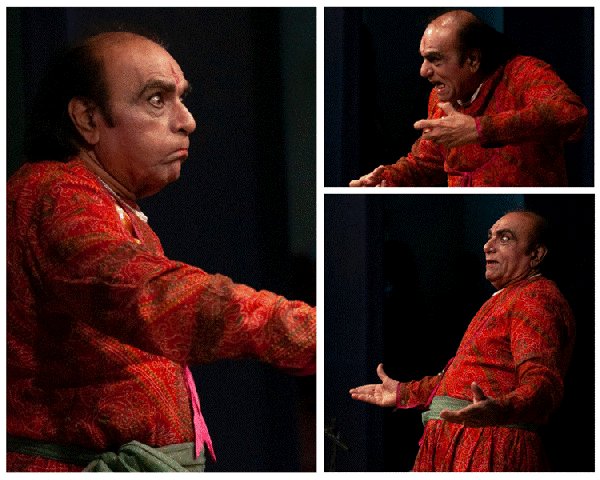 Puru Dadheech performs a section from his Sampoorna Ramayana, an unusual composition that he has written based on the odious sentiment Photos: Eknath Joshi Dr. Puru Dadheech then performed a section of his Sampoorna Ramayana with great elan and aesthetic appeal; enthralling everyone with his abhinaya technique. The Sampoorna Ramayana composed by Dr. Puru Dadheech is one of the rare compositions available today based on the bibhatsa rasa (odious sentiment). Accompanying artistes were Sukhad Munde on pakhawaj, Rahul Bene on tabla, Azharuddin Shaikh on flute, and Mayankk Kumar Swarnkar on harmonium and vocals. Festival - Day 3 On the third evening, the festival returned to Pt. Jawaharlal Nehru auditorium. The opening performance was a chaturang (a themed item with an amalgam of four segments) consisting of compositions in the Jaipur and Lucknow style performed by Rajashree Dhongade (Jaipur gharana) and Shravani and Vaishnavi (Lucknow gharana style). The chaturang was based on raag Megh Malhaar. They were accompanied by Vaishali Palsule on padhant, Charudatta Phadke on tabla, vocalist Shubham Khandalkar and harmonium by Umesh Purohit. The next performance was by Venu Riswadkar (disciple of Prajakta Raj) and Bhargavi Deshmukh (disciple of Sharvari Jamenis), in the charming tradition of senior Kathak exponent Rohini Bhate. They performed the Ardhanarinateshwar Stotra, followed by the teen taal traditional presentation of uthan, thaat, amad, paran, tukra - all elegantly composed by Rohini Bhate. Accompanying them were Siddhi Abhay on padhant, Yashwant Thite on harmonium, Charudatta Phadke on tabla, and vocalist Shubham Khandalkar. Lucknow Style The third and main performance of the evening was by Saswati Sen, prime disciple of Birju Maharaj, and Ipshita Mishra, daughter of Krishan Mohan Maharaj and granddaughter of Shambhu Maharaj. They presented the splendour of the Lucknow gharana, starting with an eternal classic composition by Birju Maharaj titled 'Shyam murat mann bhaye' which was incidentally Birju Maharaj's very first composition. 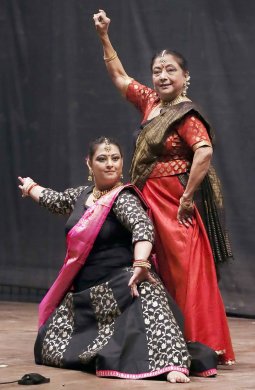 Saswati Sen and Ipshita Misra perform a duet in the Lucknow gharana of Kathak Photo: Sushil Rathod For the next performance, Ipshita Misra performed a solo on taal teentaal - upaj, uthaan, a brilliant rendering of the vilambit paran Dha Taka Thunga, and a bouquet of vibrant ginti ki tihais. She also performed a unique tihai composed by Vaswati Misra which Ipshita described as one that had the essence of a seed that is sown and how it slowly becomes a tree filled with branches and leaves and grows to eventually give shade to passersby. She performed some tukras, and pirmilu (a rhythmic pattern featuring sounds of dance, instruments, and nature) that she had learned watching her aunt Saswati Sen, her father Krishan Mohan Maharaj and her uncle Birju Maharaj perform. She had an audience interaction for one of the pieces where she asked the audience to clap when every sam was reached by the tabla player. Ipshita Misra closed with abhinaya on a devotional song Ghat ghat mein panchi dola of Kabir. Accompanying artistes were Madhuri Joshi on vocals, Charudatta Phadke on tabla, Yashwant Thite on harmonium, and Nitin Purohit on sarod. Saswati Sen then performed a lakshan geet (indicator or signifier) composition written by Birju Maharaj that vividly describes the Kathak dance form which indicated the mukh vilas, ang vilas, ang pratyang etc. Saswati Sen did a technical presentation in jhaptaal and showcased various tihais and compositions of Birju Maharaj from his last days. She ended with an alluring tihai, masterfully choreographed and performed, which had the imagery of birds, deer, and other forest animals. Saswati Sen then performed alternate tihais with Ipshita - it was a delight to watch the aunt and niece duo. Ipshita performed gap tihais, a favourite of Birju Maharaj and manjira bol tihais. Saswati Sen and Ipshita showcased the salient features of Kathak replete with Lucknow gharana's nazakat (delicacy) and khubsurati (beauty) whilst holding the banner of Birju Maharaj's vision. Lucknow Style 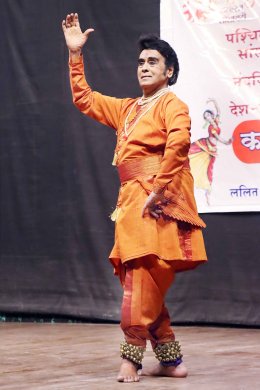 Pratap Pawar performing his famed Nayak Bhed (Photo: Sushil Rathod) Pratap Pawar, having a career spanning five decades is known abroad as India's divine dancer. In 1953 he had the honour of being the first 'ganda-bandh' disciple of Birju Maharaj. Pratap Pawar opened his performance with Nataraj raja, an ode to Lord Shiva. He followed it with the traditional Kathak intra-forms of thaat, tukra, and paran. Pratap Pawar then performed a one-of-a-kind composition, the nayak bhed (heroes in a dramatic representation classified on the basis of their nature as defined by the Natyashastra) tableau created by Birju Maharaj in 1972. He danced on the original track which was recorded with Durga Lal on pakhawaj, Devi Lal on tabla, and vocals by Rajkumar Rizvi, a highly acclaimed raga-based classical ghazal singer. Pratap Pawar shared the back story of this composition. He said when he was a young student studying nayika bhed (eight kinds of a heroine in a dramatic representation), a thought struck him as to why the nayak bhed portrayals couldn't be created in juxtaposition. He then approached his Guru, Birju Maharaj, who began working on the mission. For the dheerodaatt character (a kind of hero in ancient Indian poetics distinguished by tranquil gallantry and loftiness of conduct), Maharaj chose to portray Ram, Kansa as the arrogant and haughty dheeroddhata character, and Krishna for the cheerful and gentle dheerlalit character interested in music and arts. Pratap Pawar enacted episodes from their lives that revealed the essence of each nayak such as Ram's grace at Ahilya Uddhar, the killing of innocent children by Kansa and the Maharaas of Krishna on the banks of the River Yamuna. He closed his performance with a jugalbandi with Kalinath Mishra on the tabla. He was accompanied by Kuldeep Dubey on the padhant. Other accompanying musicians were Umesh Purohit on harmonium, and Nitin Purohit on sarod. On the sidelines of Andaaz Kathak dance festival, a Kathak gharanas seminar was held at Lalit Kala Kendra Savitribai Phule University. The seminar was moderated by Dr. Parimal Phadke, Assistant Professor at the Centre for Performing Arts, Lalit Kala Kendra, Savitribai Phule Pune University. The much-awaited Sangit Darpan Kathak book, an offering by Pt. Birju Maharaj was also unveiled for the first time. The book was launched by senior gurus Ramlal Bareth and Dr. Puru Dadheech. Sangit Darpan is a treatise on music and dance preserved by Birju Maharaj's ancestors for centuries and is now published with the original Sanskrit text, editorial notes, and translation in both English and Hindi languages. 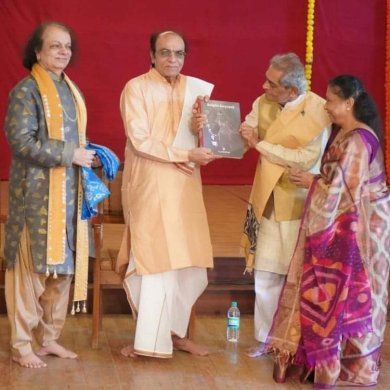 Launch of Sangit Darpan From left to right: Dr. Nandkishore Kapote, Dr. Puru Dadheech, Ramlal Bareth and Saswati Sen Photo: Tush Dadheech Congratulations are in order to West Zone Cultural Center (WZCC), Udaipur, and Dr. Nandkishore Kapote Cultural Society along with Lalit Kala Kendra for organizing this spectacular festival which highlighted the nuances and richness of each gharana. Although the lines of demarcation are fast disappearing, one could still take delight in the artistic values and distinguishing features of each gharana system as presented by the respective Gurus and senior exponents. This festival also provided an opportunity for a new generation of dancers to showcase their talent. 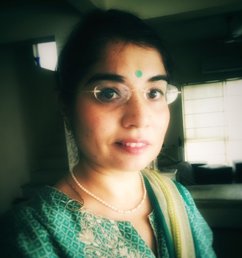 Kiran Java is a writer and holds a Masters degree in Journalism and Communication and a Bachelor's degree in Marketing from Eastern Connecticut State University, USA. She holds a Diploma in Natyashastra - Kathak relevancy under Dr. Puru Dadheech and certification in Vallabh Vedanta from Mumbai University. For more information visit kiranjava.com |